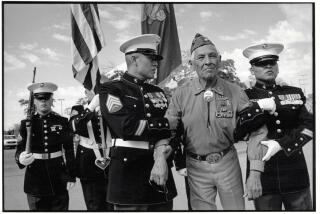‘88 Finishing Touches : ‘Bordertown’ Has Wide Impact in Southwest
- Share via
Of all the coffee-table books circulating this season, photographer Marc Gaede’s “Bordertowns” was probably among the least pleasant to unwrap on Christmas morning.
A beautifully produced book, it’s filled with sad and brutal images: of a young American Indian frozen dead in the ice, of Indians knifed in barroom brawls, of entangled drunken bodies in a huge drunk tank.
Together, the photographs chronicled the cultural suicide binge-drinking has triggered among the Southwestern Indians who leave “dry” reservations to visit “border towns,” such as Gallup, N.M.--a town of 17,000 where wine arrives from California by the railroad car and 29,000 drunks wound up in protective custody last year.
In a Jan. 10 article in The Times, Gaede, who lives in La Canada Flintridge, said his book “comes breathtakingly close to disastrous impropriety.” He suspected it might stir up trouble.
It did.
The Gallup Independent newspaper responded quickly with a feature detailing the offense taken by townsfolk.
“This book is just exploiting tragedy to make a buck,” a businessmen said.
“If he really cared about his subjects as human beings, he wouldn’t have done the book,” a Gallup lawyer said. And a local photographer offered a critique: “They are not very good photos. They’re poorly visualized, usually overexposed. Most of them are not interestingly composed and the night shots all have too much flash.”
Not all the reviews were harsh, though. The editor of Southwest Art, for instance, wrote that she was “profoundly affected by the images,” which she described as “all too human portraits that document an American malaise.”
In the year following the book’s publication, both the Albuquerque Journal and the Albuquerque Tribune ran major series on the tragic effects of Indian alcoholism and binge drinking--articles that had reportedly been planned before Gaede’s book hit the stores.
The cumulative impact of the scrutiny, according to many observers, has been to prick the Southwest’s collective conscience, accelerating the reform that had been plodding forward for year.
Among other signs of progress, state liquor board laws against selling alcohol to intoxicated patrons are now more intently enforced, said Gallup Mayor Edward Munoz, who is working with citizens groups to limit the hours liquor stores remain open, close the town’s drive-up liquor windows and to see that tax on liquor sales is routed to solving alcohol-related problems.
The Gallup Police Department has received more money to deal with drunk drivers, has added innovative procedures for handling the drunks it picks up for protective custody, and has placed limits on the number of people housed in the town drunk tank, said Sgt. John Schaaf of the Gallup Police Department. And New Mexico’s congressmen, working with local civic and tribal leaders, plan to hold hearings in Gallup to discuss the problem and to introduce legislation in 1989 to improve funding for treatment and rehabilitation of American Indian alcoholics.
More to Read
Sign up for our Book Club newsletter
Get the latest news, events and more from the Los Angeles Times Book Club, and help us get L.A. reading and talking.
You may occasionally receive promotional content from the Los Angeles Times.










